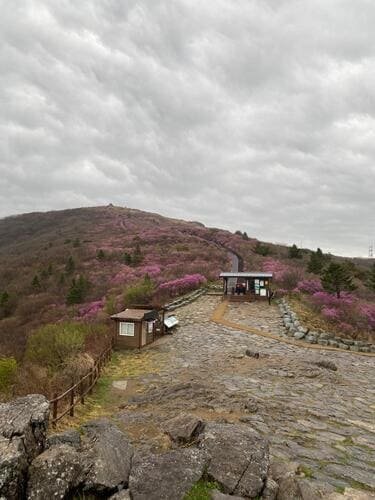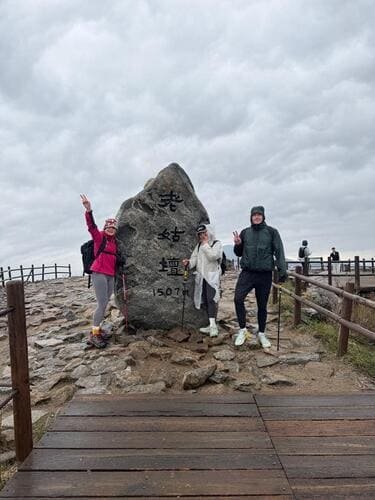South Koreans generally embrace an active lifestyle, with people of all ages prioritizing physical fitness and well-being. Visit any gym in the country, and you'll find a complete demographic representation. If you're lucky, you might even become friends with the Halmeoni (grandmothers).
However, the most popular way for Koreans to stay active is through hiking. Hiking is deeply ingrained in society. Like gyms, mountains are enjoyed by people of all ages. It's not uncommon to see elderly Koreans on mountain trails that Westerners decades younger would not consider. But it's no surprise that hiking is popular, given that the country's landscape is approximately 70% mountains, offering a great escape from the stressful lives in hectic, densely populated cities and a way to connect with nature.
In this post, we'll introduce three of the best parks in South Korea for your enjoyment. Whether you are an experienced hiker or a complete beginner open to an adventure, you should consider one of these parks on your next trip.
Bukhansan National Park - The Most Visited Mountain in Korea
Located just 20-30 km north of Seoul, Bukhansan National Park, a UNESCO World Heritage site, is renowned for its accessibility and popularity, earning a Guinness World Record for the most visited national park per unit area. Its proximity to Seoul makes it a favorite among locals and travelers.

At 837m, Baegundae Peak is Seoul’s highest point, offering breathtaking city views. The park also features a 2,000-year-old fortress and over 100 Buddhist temples and hermitages, blending natural beauty with cultural heritage. With 13 trails ranging from 1.9 km to 6.5 km and difficulty levels from easy to moderate, there’s something for everyone. Beginners can opt for shorter routes, while combining trails offers longer adventures. Baegundae Peak is a must-visit for first-timers, with well-marked paths and vibrant hiker communities.
Seoraksan National Park - The Rock With 6 Peaks
All the way to the northeast of Seoul, you'll find Seoraksan, known for its stunning autumn foliage. Though farther from Seoul (a 2-3 hour drive), it’s ideal for those on a road trip or with a rental car. The park boasts about 30 peaks, with Daecheongbong Peak (1,708m) being the tallest—twice the height of Bukhansan. A standout feature is Ulsanbawi Rock, a striking formation with six jagged peaks, accessible via a separate trail and perfect for a shorter hike.

Seoraksan offers 14 trails ranging from 1 km to 23.9 km, catering to all skill levels. Beginners can enjoy shorter, scenic routes, while advanced hikers can tackle longer, more strenuous paths. After your hike, unwind at Surfy Beach in nearby Yangyang for a relaxing coastal retreat.
Jirisan National Park - One of the Three Sacred Mountains
Spanning three provinces in southern South Korea, Jirisan National Park is home to the country’s second-tallest mountain, Jirisan (1,915m), revered as one of Korea’s three sacred peaks. Located over two and half hours from Busan, it’s less accessible but rewards those who venture there with serene landscapes and spiritual significance. The park is perfect for seasoned hikers or those exploring the southern region.


Jirisan features 16 trails from 3.1 km to 21.5 km, offering options for all levels. The sacred Cheonwangbong Peak is a highlight, though its trail is longer and more challenging. Jirisan also houses seven major Buddhist temples,including the renowned Hwaeomsa Temple, a cultural treasure. Unfortunately, you'll find Hwaeomsa Temple and Cheonwangbong Peak on the same course, both a bit on the longer and more difficult side.
Important: Certain trails in Jirisan require advance booking to manage hiker numbers and ensure safety. Make sure to reserve your preferred trail in advance via the official booking site to secure your spot.
Tips for Hiking in South Korea
Best Seasons
Unless you're a huge fan of humidity and mosquitoes, it's probably better to avoid the mountains in summer. The best seasons for hiking are in spring from April to June, and autumn from September to November, when the weather is mild and the scenery is beautiful, with cherry blossoms in spring or beautiful foliage in fall.
Pack Like a Local
Bring hot water, cup ramen, and kimbap for a traditional trailside meal.
Embrace the Culture
Expect to hear “Paiting!” (Fighting!), a cheerful encouragement among hikers. Join in or cheer others on. Older hikers (Ajeossi or Halmeoni) may strike up conversations—learn basic Korean phrases like “Annyeonghaseyo” (hello) and “Gamsahamnida” (thank you) to enhance interactions.
South Korea’s mountainous terrain and vibrant hiking culture make it a paradise for outdoor enthusiasts. From the accessible trails of Bukhansan to the sacred peaks of Jirisan, these national parks offer a perfect blend of nature, culture, and adventure. Lace up your hiking boots, dive into this beloved aspect of Korean life, and discover the beauty beyond the cities. Paiting!





